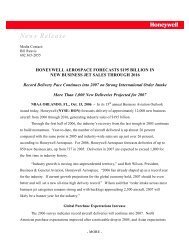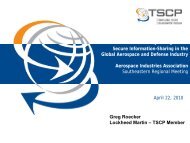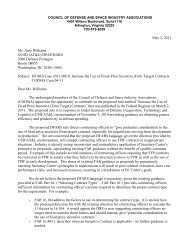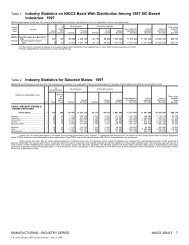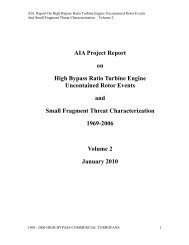Untitled - Aerospace Industries Association
Untitled - Aerospace Industries Association
Untitled - Aerospace Industries Association
Create successful ePaper yourself
Turn your PDF publications into a flip-book with our unique Google optimized e-Paper software.
2005 U.S. Commercial Space Transportation Developments and Concepts Reusable Launch VehiclesGovernment RLV Development EffortsThroughout the 1980s and 1990s, both NASA andthe U.S. Department of Defense (DoD) conductedseveral joint and independent programs to produceexperimental RLVs. These vehicles were intendedto improve reliability, minimize operating costs, anddemonstrate “aircraft-like” operations. None of theseconcepts, however, resulted in a fully operationalvehicle.In 2002, both NASA and the militaryreevaluated their RLV efforts. NASA implementeda revised Integrated Space Transportation Plan(ISTP) to better coordinate its space transportationefforts with its ISS, science, and research needs.The revised ISTP continued to support the SpaceShuttle with a Service Life Extension Program(SLEP), and it restructured the Space LaunchInitiative (SLI) to accommodate the developmentinitially of an ISS CRV (crew rescue vehicle), andthen the development of a CTV (crew transfervehicle) called the Orbital Space Plane (OSP). Therestructured SLI also has a component called theNext Generation Launch Technology (NGLT) tocontinue development of next generation and subsequentgenerations of launch vehicle technology.On January 14, 2004, President George W.Bush announced a new vision to retire the SpaceShuttle and develop a new vehicle capable of carryingastronauts to the ISS and explore space beyondLEO. After the announcement of the new Vision forSpace Exploration in January 2004, NASA shutdown both the OSP and NGLT programs as it shiftedresources to Project Constellation, an effort todevelop a new CEV and related mission architectures.The SLEP is now focused on near-termShuttle upgrades given NASA’s plan to retire theSpace Shuttle fleet in 2010.In November 2004, the U.S. Congress authorizedfull funding of NASA’s $16.2 billion budgetfor fiscal year 2005 that NASA needed in order toreturn the Shuttle to flight and get the CEV developmentoff to a good start.Space ShuttleVehicles: Discovery, Atlantis, and EndeavourDeveloper: Rockwell International (now Boeing). Fleet ismanaged, operated, and maintained on the ground byUnited Space Alliance, a joint venture between Boeingand Lockheed MartinFirst launch: April 12, 1981Number of stages: 1.5Payload performance: 24,900 kg (54,890 lbs.) to LEOLaunch site: KSCMarkets served: Non-commercial payloads and ISS accessSpace ShuttleConsisting of an expendable externaltank, two reusable solid rocketboosters, and a reusable Orbiter,NASA’s STS (Space TransportationSystem), commonly referred to asthe Space Shuttle, has conducted113 launches from its introductionin 1981 through the final flight ofthe Columbia in 2003.The three remaining orbiters – Discovery,Atlantis, and Endeavour – have been groundedsince the Columbia accident. The Space Shuttle isthe only means available today for completingassembly of the ISS. Intending to use the Shuttleuntil 2010, NASA is committed to investing in theSpace Shuttle fleet to maintain safety and reliabilityand extend orbiter service life until its responsibilitiesconstructing the ISS are complete. NASA’s SLEPwill support and maintain the Shuttles and associatedinfrastructure through the remainder of the Shuttleprogram. NASA will consider factors includingsafety, reliability, supportability, performance, andcost reduction in prioritizing improvement projects.The Space Shuttle’s day-to-day operations havebeen managed by United Space Alliance, a Boeing-Lockheed Martin joint venture, since 1996. NASAexercised two extension options to the contract andUnited Space Alliance is now supported through theend of fiscal year 2006. NASA is working on developinga new operations contract for fiscal year 2007through the end of the Shuttle program.Federal Aviation Administration/Office of Commercial Space Transportation 23




